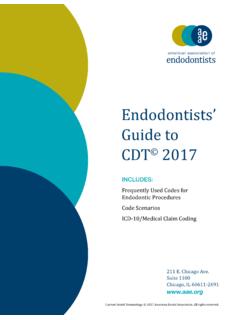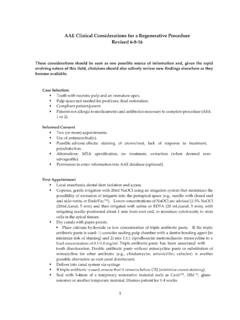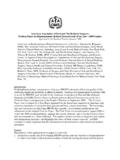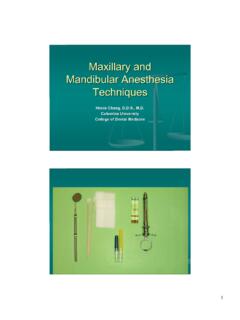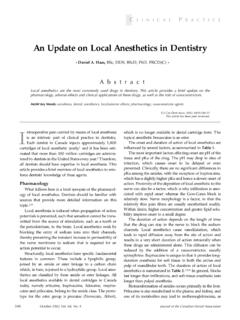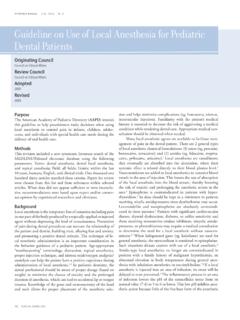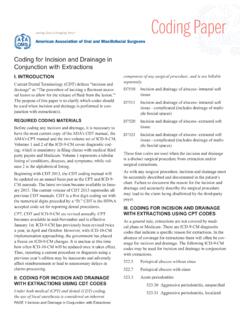Transcription of Colleagues Excellence - American Association of Endodontists
1 Colleagues for ExcellenceFall 2013 Endodontic DiagnosisENDODONTICSC over artwork: Rusty Jones, MediVisuals, for the Dental Professional Community by the American Association of EndodontistsENDODONTICS: Colleagues for Excellence2 HExamination procedures required to make an endodontic diagnosis (8)Medical/dental historyPast/recent treatment, drugsChief complaint (if any)How long, symptoms, duration of pain, location, onset, stimuli, relief, referred, medicationsClinical examFacial symmetry, sinus tract, soft tissue, periodontal status (probing, mobility), caries, restorations (defective, newly placed?)
2 Clinical testing: pulp testsCold, electric pulp test, heat periapical testsPercussion, palpation, Tooth Slooth (biting)Radiographic analysisNew periapicals (at least 2), bitewing, cone beam-computed tomographyAdditional testsTransillumination, selective anesthesia, test cavityistorically, there have been a variety of diagnostic classification systems advocated for determining endodontic disease (1). Unfortunately, the majority of them have been based upon histopathological findings rather than clinical findings, often leading to confusion, misleading terminology, and incorrect diagnoses (2).
3 A key purpose of establishing a proper pulpal and periapical diagnosis is to determine what clinical treatment is needed (3, 4). For example, if an incorrect assessment is made, then improper management may result. This could include performing endodontic treatment when it is not needed or providing no treatment or some other therapy when root canal treatment is truly indicated. Another important purpose of establishing a universal classification system is to allow for communication between educators, clinicians, students and researchers.
4 A simple and practical system which uses terms related to clinical findings is essential and will help clinicians understand the progressive nature of pulpal and periapical disease, directing them to the most appropriate treatment approach for each condition. In 2008, the American Association of Endodontists held a consensus conference to standardize diagnostic terms used in endodontics (1). The goals were to propose universal recommendations regarding endodontic diagnoses; develop a standardized definition of key diagnostic terms that will be generally accepted by Endodontists , educators, test construction experts, third parties, generalists and other specialists, and students; resolve concerns about testing and interpretation of results.
5 And determine the radiographic criteria, objective test results, and clinical criteria needed to validate the diagnostic terms established at the conference. Both the AAE and the American Board of Endodontics have accepted these terms and recommend their usage across all dental disciplines and health care professions (5, 6, 7). Each of the following diagnostic terms will be defined with typical respective clinical and radiographic characteristics along with representative case examples when appropriate. However, clinicians must recognize that diseases of the pulp and periapical tissues are dynamic and progressive and as such, signs and symptoms will vary depending on the stage of the disease and the patient status.
6 Coupled with this are the limitations associated with current pulp testing modalities as well as clinical and radiographic examination techniques. In order to render proper treatment, a complete endodontic diagnosis must include both a pulpal and a periapical diagnosis for each tooth and Diagnostic ProceduresEndodontic diagnosis is similar to a jigsaw puzzle diagnosis cannot be made from a single isolated piece of information (4). The clinician must systematically gather all of the necessary information to make a probable diagnosis.
7 When taking the medical and dental history, the clinician should already be formulating in his or her mind a preliminary but logical diagnosis, especially if there is a chief complaint. The clinical and radiographic examinations in combination with a thorough periodontal evaluation and clinical testing (pulp and periapical tests) are then used to confirm the preliminary diagnosis (4). In some cases, the clinical and radiographic examinations are inconclusive or give conflicting results and as a result, definitive pulp and periapical diagnoses cannot be made.
8 It is also important to recognize that treatment should not be rendered without a diagnosis and in these situations, the patient may have to wait and be reassessed at a later date or be referred to an endodontist. Diagnostic Terminology Approved by the American Association of Endodontists and the American Board of Endodontics (5-7)Pulpal Diagnoses (9-14)Normal Pulp is a clinical diagnostic category in which the pulp is symptom-free and normally responsive to pulp testing. Although the pulp may not be histologically normal, a clinically normal pulp results in a mild or transient response to thermal cold testing, lasting no more than one to two seconds after the stimulus is removed.
9 One cannot arrive at a probable diagnosis without comparing the tooth in question with adjacent and contralateral teeth. It is best to test the adjacent teeth and contralateral teeth first so that the patient is familiar with the experience of a normal response to cold. Reversible Pulpitis is based upon subjective and objective findings indicating that the inflammation should resolve and the pulp return to normal following appropriate management of the etiology. Discomfort is experienced when a stimulus such as cold or sweet is applied and goes away within a couple of seconds following the removal of the stimulus.
10 Typical etiologies may include exposed dentin (dentinal sensitivity), caries or deep restorations. There are no significant radiographic changes in the periapical region of the suspect tooth and the pain experienced is not spontaneous. Following the management of the etiology ( caries removal plus restoration; covering the exposed dentin), the tooth requires further evaluation to determine whether the reversible pulpitis has returned to a normal status. Although dentinal sensitivity per se is not an inflammatory process, all of the symptoms of this entity mimic those of a reversible Irreversible Pulpitis is based on subjective and objective findings that the vital inflamed pulp is incapable of healing and that root canal treatment is indicated.
